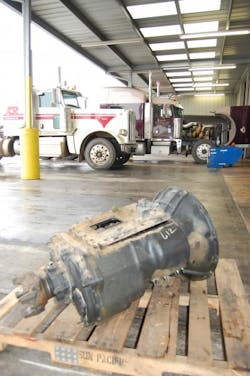That of course means that demand for various kinds of replacement parts – especially where engines are concerned – are expected to keep on increasing as many fleets decide to keep on trucking with older units rather than replace them with new ones.
But how does such sustained demand for aftermarket parts affect their availability and price? Those are two issues Ferro (seen at right) discussed as part of a white paper of the subject recently issued by Meritor.
“Many motor carriers are doing more business with warehouses and mini-parts distribution centers (PDCs) [as] they want to maximize tractor and trailer life and uptime from their current vehicle roster,” he noted.
Yet warehouse distributors, dealers, fleets and other end-users are being squeezed at every turn as they strive to increase margins and at the same time reduce costs and working capital, Ferro pointed out.
“Suppliers that are true ‘aftermarket survivors’ must flourish in this tough market by staying true to their convictions of high parts availability and responsive delivery,” he stressed. “Owners with an average vehicle age of nine to 10 years are focused on quality replacement parts availability and overall lifecycle costs. They also want a supply distribution channel with appropriate product support, counsel and expertise.”
As a result, Ferro said that fleets are “discovering” all the price points that play into the total cost of a part purchase, including sourcing, inventory requirements, order processes and shipping costs.
“They know full well that comprehensive part portfolios having low-cost, too-good-to-be-true pricing comes with issues of quality, support, resources, availability and backup,” he said. “More than ever, astute vehicle owners demand greater before- and after-the-sale support.”
As a result of all this, several new trends are forming that Ferro believes will significantly affect the aftermarket parts arena for suppliers and fleets alike. They are:
- Growth of private brands in the aftermarket: Most OEMs and many large independent distributors are creating their own parts brand to speed up repairs, drive service business into the dealerships and stores and to offer new choices to the customer.
- Greater influence of information services on the parts business: More fleet operators are becoming comfortable with shopping and buying their parts on the Internet and often go online to make comparisons. Whether looking for parts availability or learning and training tools, online information continues to play a greater role in the aftermarket.
- Appeal growing for “all-makes” parts where it makes sense: Today’s truck operators serve more markets, offer more services and support more applications than ever before, explained Ferro, so it’s not always practical for them to maintain an inventory of genuine replacement parts spanning the multiple brands of today’s mixed fleet. When suppliers implement the concept of all-makes parts, truck operators can enjoy the benefits of “one-stop shopping” while dealers and distributors can streamline inventory and capture more business regardless of a fleet’s brand composition.
- Growth of “value brand” all-makes part sales: In particular, second and third vehicle owners are turning to “value brands” or all-makes parts due to lower costs, proven performance criteria and extensive laboratory testing of parts. “Good-enough” parts typically don’t hurt on-highway fleets because the parts usually take the vehicles through to trade. The refuse industry tried “good enough,” but after finding the price compromise equaled shorter component life, made a quick retreat back to “genuine” long-life components.
- Spec’ing software to drive more of the parts strategy: To deliver application-specific requirements for transit, utility, military and municipal vehicles, suppliers must know and prepare for specific vocational demands, said Ferro, so field representatives use spec’ing software can now better help determine what specific components will deliver the best performance for the way a vehicle is being used at the time of repair.
- Continued growth in remanufactured components: Key advantages include lower cost, nationwide warranty and reliable quality. Remanufactured truck and trailer components are products of a process that includes disassembly, cleaning, rigorous inspection and qualifying, in addition to replacement, reassembly and testing. Ferro thinks reman components are ideal for customers who want performance, service life and warranty support without the cost of new components. Remanufacture of trailers, chassis, and even tractors built with glider kits is a new trend in the aftermarket business.
While CMVC’s CV Parts Aftermarket Leading Indicator (PLI) decreased 0.2% in November to 100.82, following 0.3% decrease in October (January 2001 = 100), Brady said that won’t generate a large influence in parts aftermarket sales, since the commercial vehicle population and truck utilization remain relatively unchanged.
He added that in 2013, U.S. Class 8 truck retail sales were approximately equal to replacement demand, so over the past three years, U.S. Class 8 truck retail sales have been roughly equal to replacement demand volumes implying a stable truck population.
Yet while a so-called “stable” truck population over an extended period of time implies parts with short life-cycles, such as oil filters, will be relatively flat, parts with long life-cycles, such as engine overhaul kits, are expected to increase in 2014 as increasing number of trucks sold during the 2004 to 2006 strong truck sales period are coming in for major repairs/overhauls.
CMVC predicts parts with medium life-cycles, such as brake drum will remain relatively soft, since the population of trucks three-to-six years old will remain near the trough of the current cycle.
Meritor’s Ferro, though, added that three other trends may also begin to affect the aftermarket parts arena in some interesting ways:
- Electronification: As more fleet vehicles are equipped with advanced electronics for vehicle diagnostics to enhance operating efficiencies, there could be opportunities for the aftermarket to keep these systems serviced and in ideal shape. Vehicles with these systems will require even more electronic diagnostics capability and software-on-demand, such as delivery of calibration codes at service locations. Just as OEMs strive to maximize performance and minimize downtime, the aftermarket must also deliver service parts in a speedy, if not anticipatory, mindset that aligns on-hand parts inventory with immediate needs. This alignment is needed to hopefully limit a truck’s time in the service bay to 24 to 72 hours from the time of arrival.
- Lowest cost of ownership or lifecycle cost management: Larger fleets are driving and managing a continuous rationalization of assets, and many are extending vehicle life from six or seven years to eight or 10 years. To keep those trucks – and trailers – on the road, motor carrier management must step up their care-replace-service-maintain practices and processes. This includes the right parts at the right time, with “one-stop shopping,” wiser use of quality remanufactured components, and in the case of some fleets, glider kits outfitted with remanufactured drivetrain components.
- Greater demand for training and education: Training remains paramount in customers’ minds. In an age of “buyer beware,” aftermarket parts dealers, warehouse distributors and independent service garages can play an increasing role in helping customers understand proper service and replacement procedures. In addition, training can help increase the number of parts choices and what fleets trade off when cost-cutting or price is the top priority. Again those become additional variables in calculating total parts cost.
“Fleets can no longer wait one or two days to get a truck back on the road; that’s why the ‘parts business’ has become a ‘now’ business,” Ferro explained. “Yet a component that ‘just fits’ a given make and model may not necessarily meet the customer’s need for performance, longevity and – especially – value. Our job is to manage complexity and variation and, above all, to help keep trucks and trailers moving freight efficiently and safely.”
Trends to keep in mind as the demand for replacement parts is poised, it seems, to only keep on growing.





